How to Choose a Hand Plane
A Woodworker’s Guide for Choosing the Best New and Vintage Woodworking Hand Planes (Part 1/3)
![]() By Joshua Farnsworth | Updated Feb 28, 2022
By Joshua Farnsworth | Updated Feb 28, 2022
How to Choose a Hand Plane
A Woodworker’s Guide for Choosing the Best New and Vintage Woodworking Hand Planes (Part 1/3)
![]() By Joshua Farnsworth | Updated Feb 28, 2022
By Joshua Farnsworth | Updated Feb 28, 2022
Disclosure: WoodAndShop.com is supported by its audience. When you purchase through certain links on our site, we may earn a small affiliate commission, at no cost to you. Learn more.
Introduction to Hand Plane Buying
The traditional woodworking hand plane (often called a “hand planer” by new woodworkers) seem to be the most popular tools in traditional hand tool woodworking. Hand planes make the most exciting changes to your wooden work piece. And that high-pitched swoosh sound is music to a woodworker’s ears!
Below I’ll talk all about different types of hand planes, and share advice on buying handplanes. You can either read straight through or use this table of contents to skip to a particular section:
What is a Hand plane?
New woodworkers might be wondering what a hand plane is. A hand plane (also spelled “handplane”) is basically a sharp chisel that’s held at an angle, in a wooden or metal body, that allows you to flatten, smooth, or shape a board for furniture making. Hand planes come in many different shapes, sizes, and materials. Heck, I’ve got well over 100 different handplanes. So I know it can be really confusing to understand which handplanes you need. But don’t worry, in this article I’ll try to simplify this for you and show you which handplanes to get first, which ones can wait until later, and which ones you may never need.
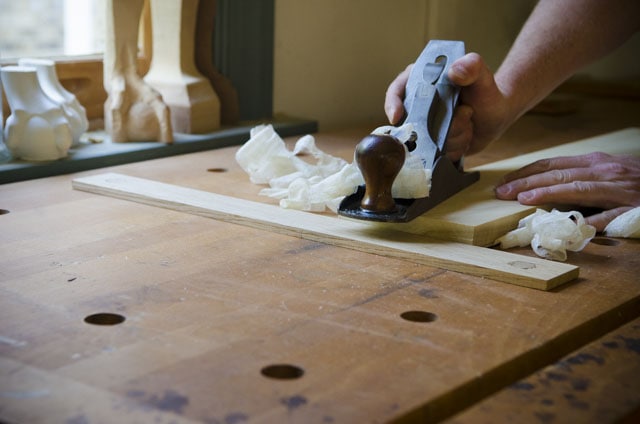
Below I’ll start off by briefly introducing you to the three main hand plane categories: Bench Planes, Joinery Planes, and Molding Planes.
RELATED
Which 20 Woodworking Hand Tools Should You Buy First?
Why Traditional Hand Tool Woodworking?
10 Jaw-Dropping Woodworking Shop Tours
57 Page Moravian Workbench Plans Now for Sale
How to Make a Mortise and Tenon Joint with Woodworking Hand Tools
8 Steps to Cutting Dovetails with Woodworking Hand Tools
Different Types of Hand Planes
In this woodworking hand tools buying guide article I’ll be discussing the hand planes that you need when starting out in traditional woodworking. Hand plane bodies can be made of all wood (wood plane), all metal (like Stanley planes), or a hybrid of both (Transitional Planes). I’ll elaborate on that later in this article. But first, in my mind I divide hand planes into three general categories:
1. BENCH PLANES
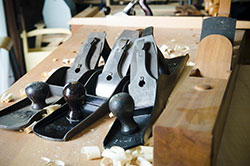
Bench planes are hand planes that are used so often that they usually “sit on the bench” and are used for flattening, dimensioning, & smoothing wood. Examples include Jointer Planes, Jack Planes, Smoothing Planes, and Block Planes.
2. JOINERY PLANES

Joinery hand planes are specialty planes used for creating or finishing joints. Examples include rabbet planes, plow planes, shoulder planes, tongue & groove planes, router planes, etc.
3. MOLDING PLANES
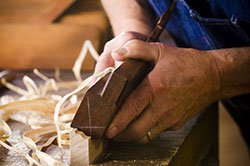
A molding plane (or “moulding” plane) is a wood plane that is used for cutting decorative profiles on a board. Examples of molding planes include dedicated molding planes, hollows & rounds, snipe bills, beading planes, etc.
1. Buying Bench Planes
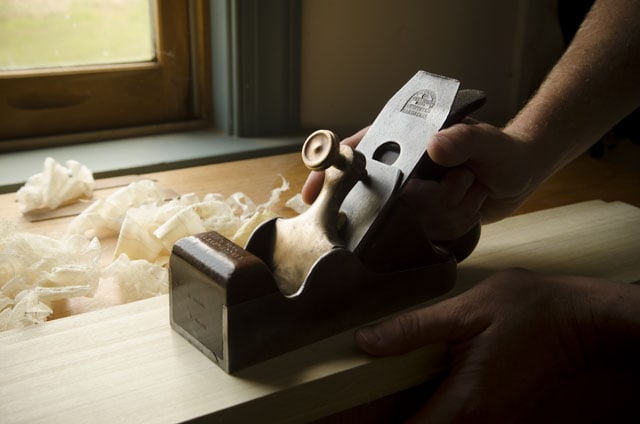
Bench planes are hand planes that are used so often that they’re often sitting on your workbench. Bench planes are used for shaping, flattening, dimensioning, and smoothing boards. As I showed in my video & article on squaring up boards with hand tools, the basic set of 3 or 4 bench planes would be these:
Jack Plane / Fore Plane / Scrub Plane
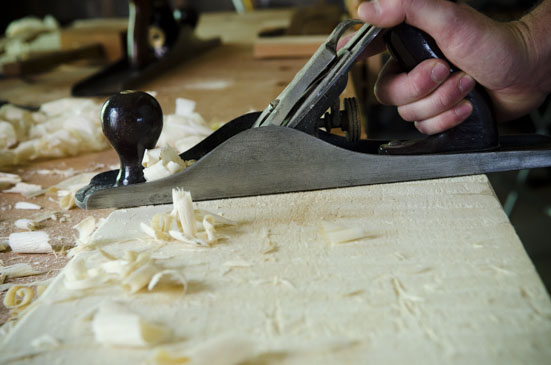
A jack plane (or a “fore plane”) is used for the initial rough flattening of a board. This handplane is sharpened with an extreme camber, or “arc”, and has a wide open moth, which allows for easier and faster rough removal of the wood, especially when planing across the grain. This is called “scrubbing”. These handplanes excel at getting the twist out of the board, and getting it more-or-less flat. Dedicated scrub planes are smaller than a jack plane, but are used for the same purpose.
Jointer Plane / Try Plane
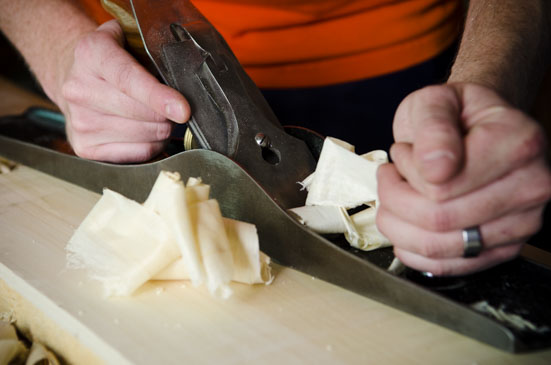
The next hand plane to touch the wood is a jointer plane (or a “Try plane”). This very long handplane is ideal for precision flattening of a board (after the jack plane rough-flattened it), and it gives a nearly finished surface. It skips along the high spots and gradually brings them all down together. It’s also used for “jointing” the edge of a board, or creating a precise 90 degree edge to the flattened face. This is essential for when you need to glue up boards for a table top.
Smoothing Plane
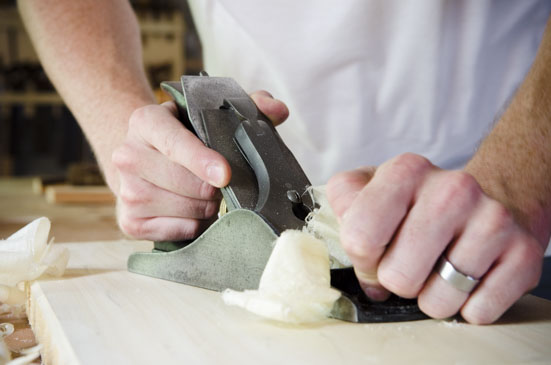
The last plane to touch the wood is a shorter hand plane called a smoothing plane. It’s job is mainly for finishing the surface of the wood. A highly-tuned smoothing plane with a tight mouth can give a sheared surface that’s superior to what sanding can do.
Block Plane
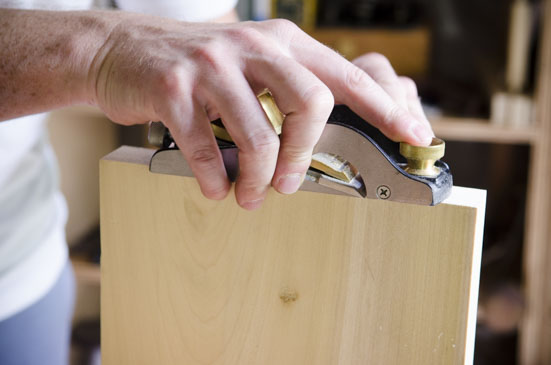
I also throw block planes into the bench plane category, because I use them so often. Block planes haven’t been around as long as the other bench planes, but they’re certainly useful for a lot of smaller detail work, especially for trimming the end grain of boards.
The 6 most common styles of bench planes:
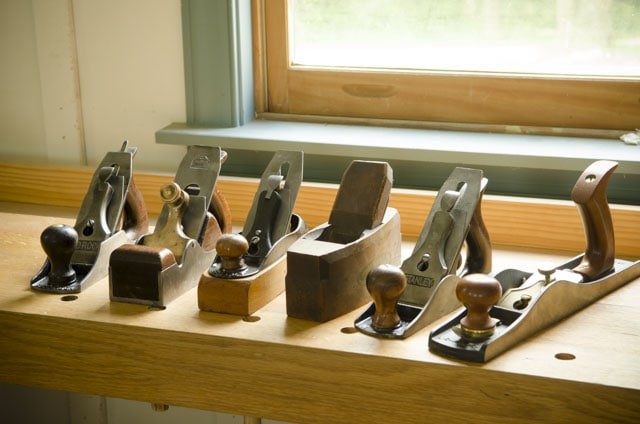
In addition to the four different types of bench planes, you also need to consider what style of bench plane you want to buy. This is not to be confused with the brand. The style largely determines the price, and sometimes the performance. Here are the 6 most common styles of bench planes:
Wooden Bench Planes
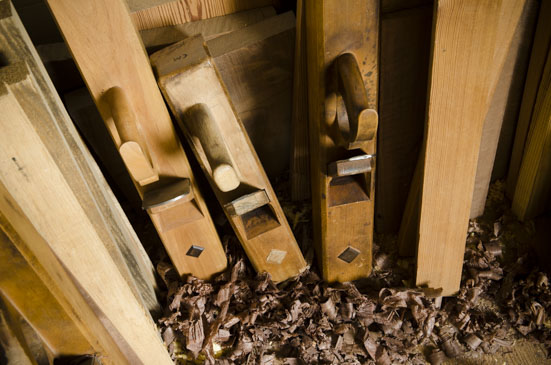
Wooden planes are the oldest style of hand plane. Most of the finest furniture in history was made with wooden handplanes. And some of my favorite hand planes fit into this category. Wooden planes are also usually the most affordable bench planes. I could easily put together a good set of antique wooden bench planes for under $100.
The oldest style of wooden bench plane has a simple metal iron (i.e. blade) that’s held tightly in place with a wooden wedge. Later wooden bench plane models introduced a chip breaker onto the iron, to reduce throat clogging. Wooden planes take a little more work to adjust than metal planes, but it’s not difficult to learn. And it can be fun. You advance and laterally adjust the iron with some taps on the top and side of the iron, and you set the iron in place by tapping the wedge. If you’ve gone too far, then you can loosen the iron by smacking the heel of the plane with a mallet, by whacking the strike button, or by smacking the top of the handplane. I actually find it quite enjoyable to adjust wooden planes.
Wooden smoothing planes and jointer planes can be finicky to get rehabbed & tuned up just right, but the planes aren’t expensive, so it’s worth the experiment. And once they’re tuned up, they’re sweet to use. And they have a great historical look!
Bailey Bench Planes
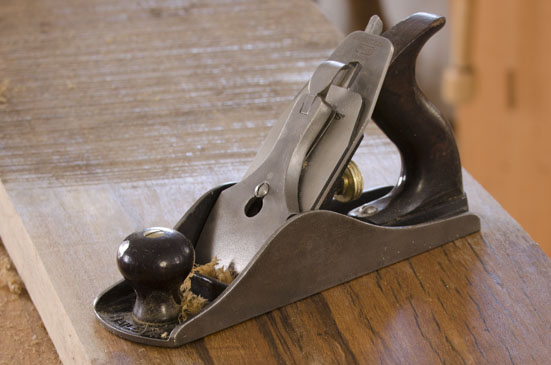
Now we’ll jump into metal handplanes by talking about the most common style you’ll encouter: the Bailey patent style. The Bailey style planes were patented by Leonard Bailey in the mid 1800’s, and his revolutionary design really influenced most handplanes that followed. Because of his design that featured an adjustable cutting depth and lever cap, the Stanley Rule & Level company purchased his manufacturing company and patents, and manufactured millions of these planes. By the early 1900’s Stanley was casting the “Bailey” name into the body of the planes. These handplanes are the most common type of metal bench plane, and relatively affordable. However, the prices of Stanley Bailey planes have jumped in recent years. But you can still find some good deals. These Stanley Bailey planes range in size from a baby-sized #1 plane all the way up to a monster #8 jointer plane, with some fractional sizes in-between. When shopping for vintage Stanley Bailey planes you’ll notice a “type” number. That refers to the version. Every time new advancements were made, they would be released as a new “type”, ranging from type one all the way up to type 20. Opinions vary, but most people feel that the quality peaked between type 11 and 13, and that the quality sharply declined during and after World War 2. You can visit my type study page to see how old your Stanley Bailey handplane is. Some modern manufacturers make planes in this Bailey style, though I haven’t tried any that I’ve found to be as good as the vintage planes.
Bed Rock Bench Planes
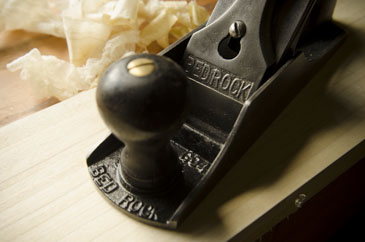
Bed Rock handplanes were a superior line of bench planes manufactured by Stanley, based on patents from some other ingenious people. The Bed Rock planes get their name from the solid and smooth machined casting that the frog sits on, which leads to less chance of vibration while handplaning a board. In my opinion this is the most important feature of the plane. This style of plane also features an easier mechanism for opening and closing the mouth; using adjustment screws on the rear of the frog, without having to unscrew the frog, like you do on the Bailey style planes.
Bed Rock planes follow a similar sizing system, though the number start with a “60”. For example, the Bed Rock version of a Bailey number 4 plane would be “604”.
The price of vintage Bed Rock style planes are astronomical compared to the Bailey style planes, due to the superior design and the comparative scarcity. However, a Bailey style plane will work great for you.
There are a couple higher-end modern manufacturers who produce Bed Rock style planes. The price tag is high, but not a lot higher than vintage Bed Rock planes. And you don’t have to refurbish them. I’ve listed the names and models of these planes that I recommend later on in this article.
Transitional Bench Planes
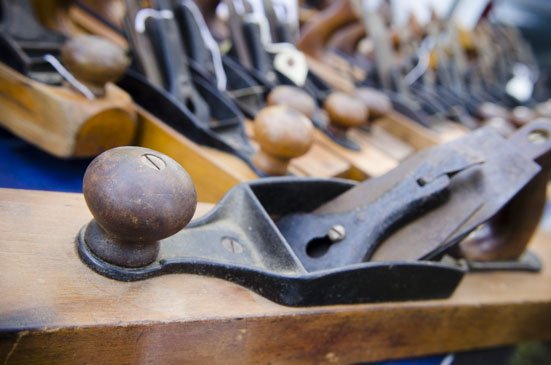
Transitional hand planes are a cross between a wooden handplane and a metal handplane. They have metal parts with a wooden body. You may think that they were the evolutionary link between wooden bench planes and metal bench planes, but they were actually released after the initial metal bench planes. From what I understand, it was to appeal to people who liked the adjustability of metal planes, but missed the wooden soles and bodies of the all-wooden bench planes. It could also have been a way for tool companies to offer a more affordable line of bench planes.
Transitional handplanes are a lot more affordable than all-metal handplanes…usually under $25 if you shop at the right places. Sometimes I find transitional planes challenging to get tuned up to the level required for a smoothing plane or jointer plane, but the risk of trying them out is low because the price is so low. And they work wonderfully as a jack plane, because Jack planes are used for rough work, and don’t need to be highly tuned. But I’ll discuss that in the next section, which is on jack planes.
Bevel-Up / Low-Angle Bench Planes
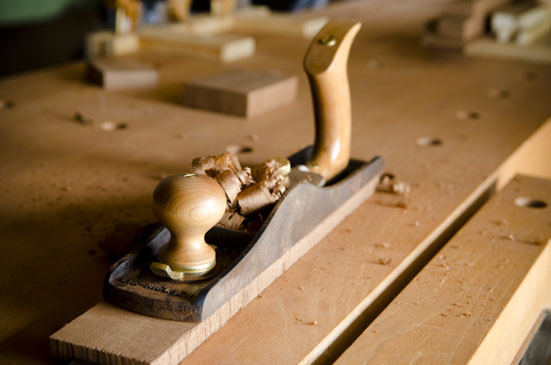
A less common vintage bench plane design that originated from Stanley, is the low angle bevel up handplanes. Stanley originally sold a couple jack plane sizes (62 & 64) and a smoothing plane size (164). They’re essentially a hybrid between a bench plane and a block plane. This style of handplane doesn’t have a movable frog, but uses an adjustable mouth opening mechanism instead. It also doesn’t use a chip breaker like bevel down planes use. The solid iron simply sits firmly against the low angle plane casting. This style of plane has gotten some traction in recent years as several modern plane makers have tried to resurrect the style. It has some nice flexibility because, depending on how you sharpen the iron, it can be used as a low angle plane for cutting end grain, as a normal bench plane for standard handplaning, or as a high angle plane for planing difficult figured wood grain. But buying two extra blades can get expensive.
The vintage bevel up planes have some design flaws, and are also so rare that the prices are way too high. So I tend to prefer the modern versions from a couple different plane makers. But I’ll talk more about bevel up handplanes in a few minutes.
British Infill Bench Planes
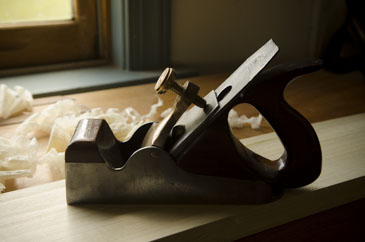
If you’ve got a large tool budget and want the nicest and most lovely handplanes available, then look at vintage British infill planes, often called Scottish infill planes.
These incredibly well-made metal planes were usually made to very high tolerances. They are very rigid & heavy (to avoid vibration), they have thick irons and chip breakers, and have tight mouths, which are all ideal for making fine shavings on hardwoods. Many of these planes are sought by collectors at very high prices…I’m talking in the thousands of dollars. But you can look for relatively inexpensive user-grade planes, which aren’t in mint condition, and are priced to be used in your workshop rather than being stored in a case or a vault. You can opt for a nice infill plane, like the one shown above, that lacks a brand name, which further lowers the price.
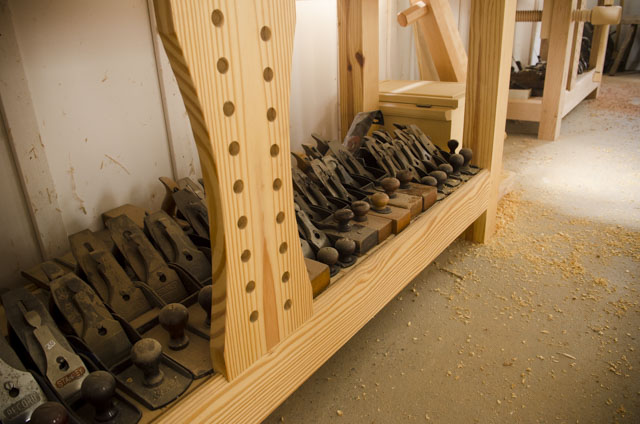
Now that we’ve gotten the handplane classification out of the way, let’s move onto advice about buying specific bench planes: jack planes, jointer planes, smoothing planes, and block planes:
Buying Jack Planes / Fore Planes / Scrub Planes
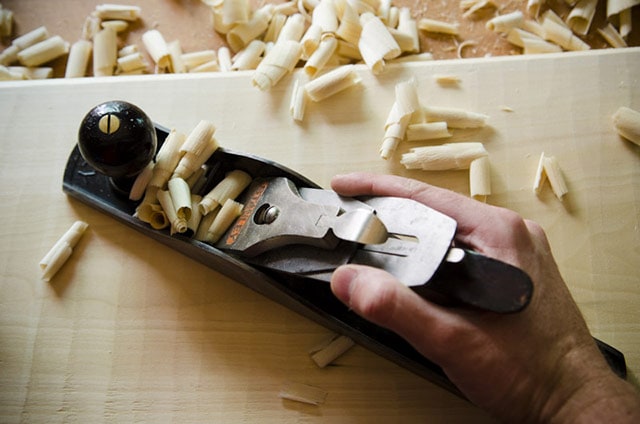
As I mentioned earlier, a Jack Plane or a fore plane or a scrub plane is the first handplane to touch your rough-sawn board. These handplanes are typically used across the grain for rough wood removal, or “scrubbing” with a highly cambered (i.e. “arched”) iron. I prefer a larger Jack plane or an even larger Fore plane over a dedicated scrub plane. Because it’s used for rough work, I typically don’t tune these planes up as much as I do with the other bench planes.
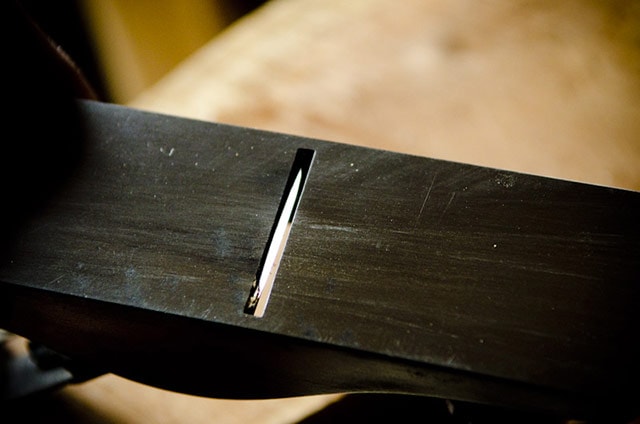
Precise features that may be desirable on a smoothing plane or a jointer plane, like a tight mouth for example, are usually not desirable on a jack plane. See (above) how the plane has such a wide open mouth to allow rough wood shavings to exit? This is great news for woodworkers who are on a budget, because I don’t recommend that they spend a lot of money on a jack plane. Spending hundreds of dollars on a jack plane just doesn’t make sense to me, no matter how big someone’s budget is.
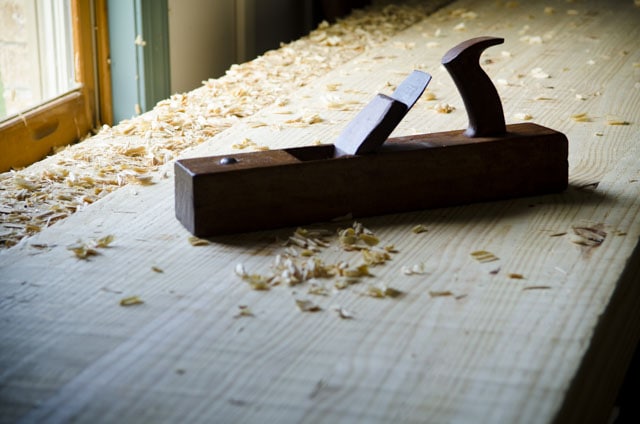
In fact, some of my favorite jack planes are the most affordable planes on the market. The antique wooden plane pictured above is my favorite jack plane. Click here to see similar wooden jack planes on Ebay. Yes, wooden planes can take more time to adjust, but because I don’t use this plane for anything besides scrubbing, I rarely have to adjust it. This plane cost me around $15.
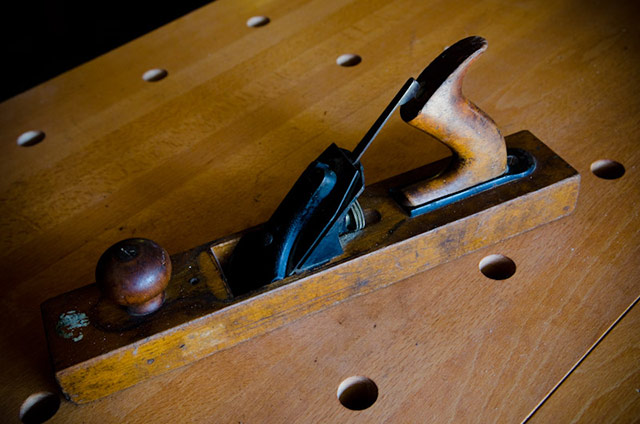
Another fantastic candidate for scrubbing are vintage transitional jack planes (pictured above), which I mentioned earlier. As I said, transitional planes work fantastic as a jack plane, because Jack planes don’t need to be highly tuned. Also, if used as a jack plane, they don’t require much rehab work at all. Just avoid buying a plane that has obvious major problems, like cracked metal parts, major cracks in the wooden body, badly broken totes or knobs, or missing parts, because buying replacement parts are often more expensive than buying the plane itself.
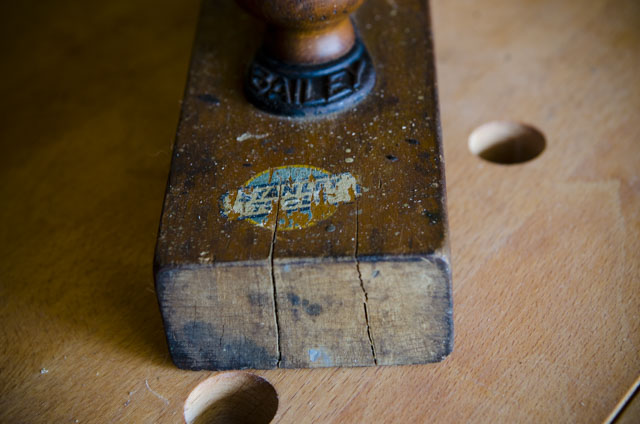
A transitional jack plane in good condition shouldn’t cost you more than $25 and is perfectly suitable for rough stock removal. It won’t likely give you gossamer shavings, but for making ugly wood chips fly, they work just as well as any expensive jack plane. Here are some of the models that I own and enjoy using:
- View Stanley No. 26 Transitional jack planes
- View Stanley No. 27 Transitional jack planes
- View Stanley No. 28 Transitional jack planes
- View Ohio Tool Co. No. 027 Transitional jack planes
- View Sargent No. 3418 Transitional jack planes
- View all Transitional planes on Ebay
If you’re on a tight budget, these wooden planes and transitional planes will save you a lot of money. And if you combine them with a good wooden smoothing plane and a good wooden jointer plane, you can keep your bench plane budget under a hundred dollars. Not bad considering some new metal bench planes cost over $400 for one plane!
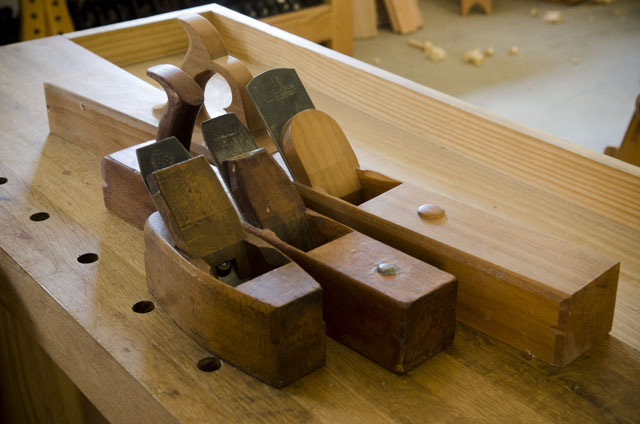
I’ll talk more about finding a good, affordable wooden smoothing plane and jointer plane in the next sections. But let’s look at some other options for Jack planes:
What if you want a metal bench plane, but can only afford one to start with?
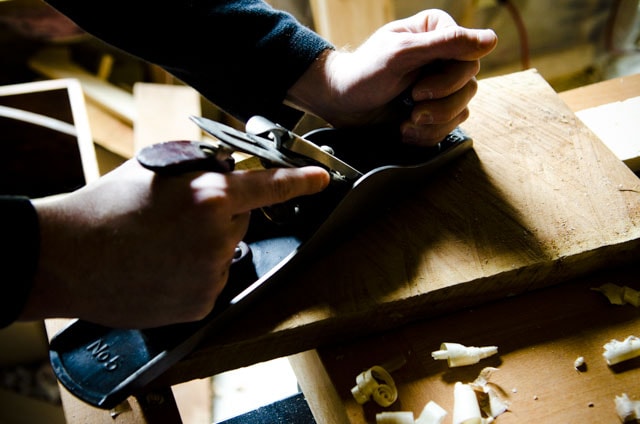
If you want to eventually acquire a set of metal bench planes, but can only afford one to start with, then I’d recommend buying a metal number 5 jack plane. These Jack planes are the most common planes available, and were manufactured in the millions. Stanley was the largest producers of metal bench planes, and this was their most common size. The prices range anywhere from $15 to $50 for jack planes that need rehab work. I personally wouldn’t pay more than $50 (no, I didn’t pay anywhere close to $56 for the No. 5 jack plane pictured below).
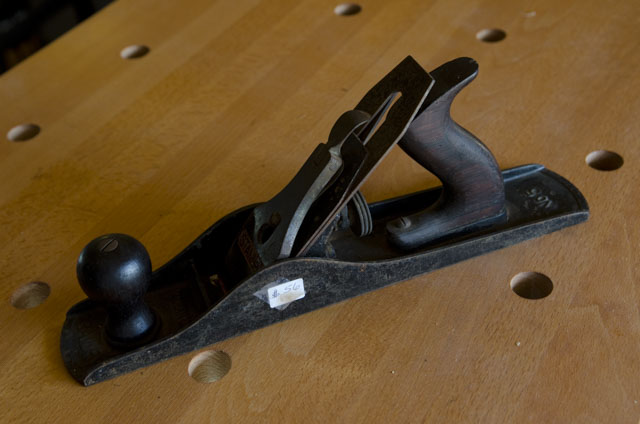
If this will be your only handplane at first, then you’ll need to spend extra time tuning it up to the level of a smoothing plane, because you’re going to use it for all three jobs: rough-scrubbing, flattening & jointing, and smoothing.
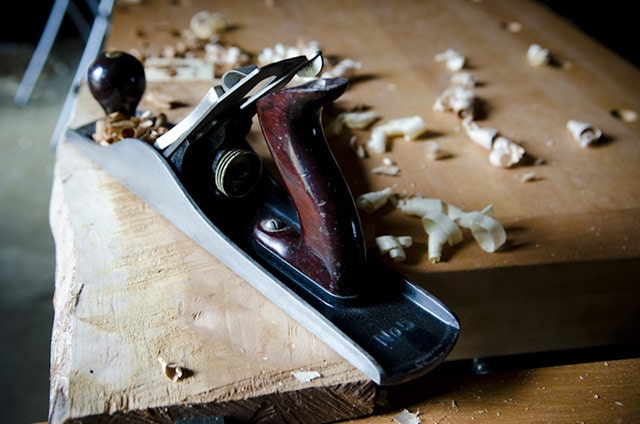
This option won’t work as well as having three dedicated bench planes, but it can work fairly well. This is how it can work: When you buy a metal number 5 jack plane, also buy a second iron. Sharpen one iron with an extreme camber for scrubbing a rough board:
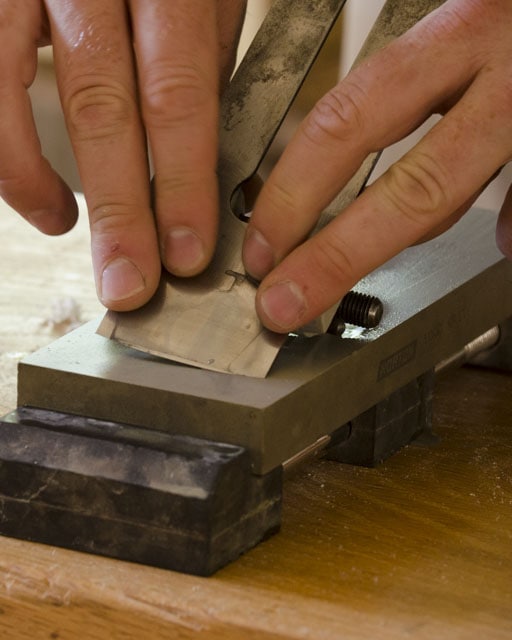
And then sharpen the other blade with a barely noticeable camber for smoothing and jointing:
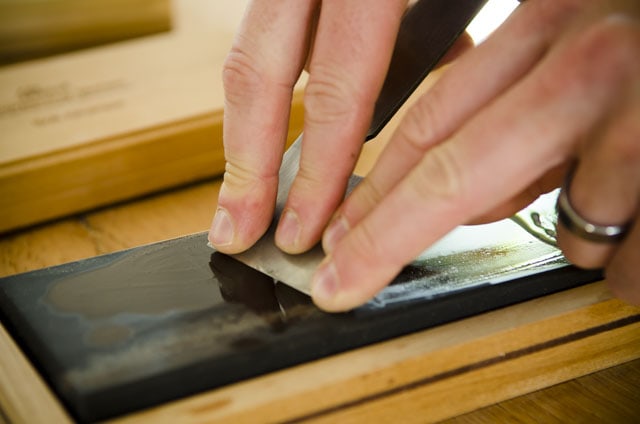
And then you can just swap the iron out depending on the work you’re doing.
A jack plane can actually work perfectly as a jointer plane, as long as your board is less than three times the length of the jack plane. For example, the number 5 jack plane pictured below is 14-inches long, so it would technically be a jointer plane for any board under 42 inches…give or take…so it’ll will work great for flattening and jointing along the length of the board. Many furniture parts are under this length, so a jack plane is quite flexible as a jointer plane.
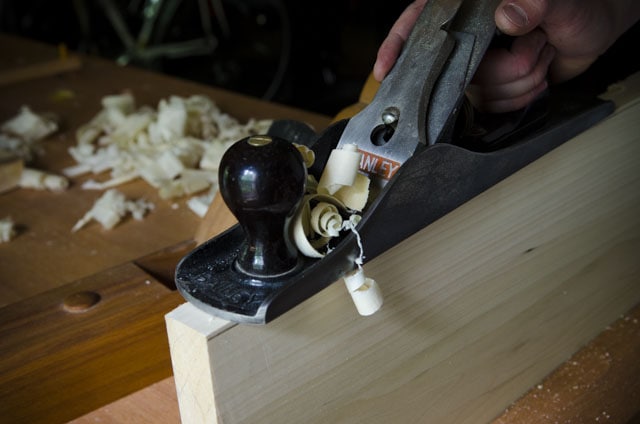
And the jack plane can work somewhat well as a smoothing plane. However, it would be difficult to get into small areas of difficult grain to smooth it, with such a long plane. When you switch from the smoother or jointer setup to a scrubbing setup, you would just switch out the blade and adjust the frog mechanism to open the mouth to allow the big wood shavings to exit.
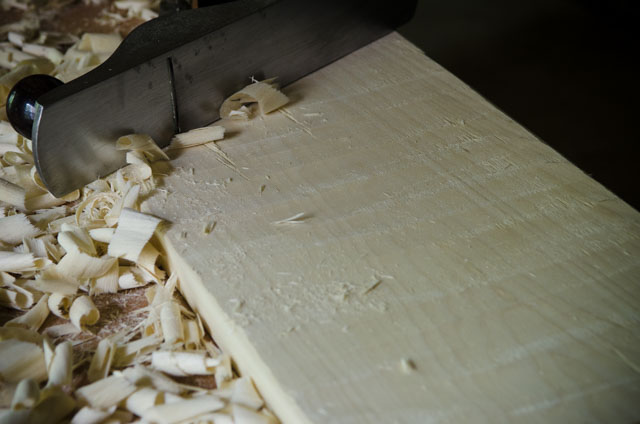
Here are some good Jack planes to search for on Ebay:
- View vintage Stanley No. 5 Jack Planes on ebay
- View vintage Record No. 5 Jack Planes
- View extra irons & chip breaker for No. 5 Jack Planes (to use as scrub plane blade)…same blade as No. 4 plane.
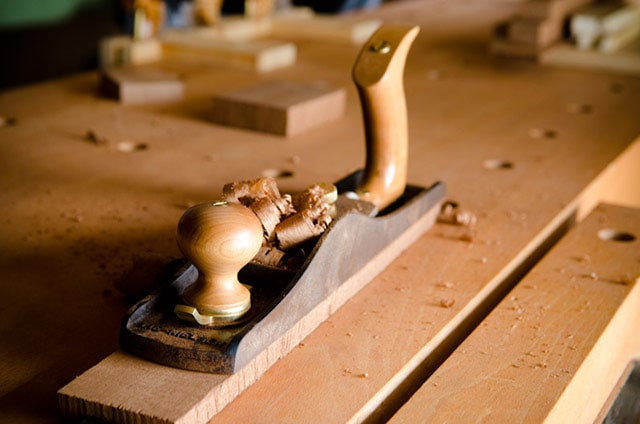
If you want to go the route of a single bench plane, but don’t feel confident with rehabbing a handplane, then I’ve got another option for you to consider, though it’s quite a bit more expensive than the previous options. A few companies make these low angle jack planes (pictured above and below).
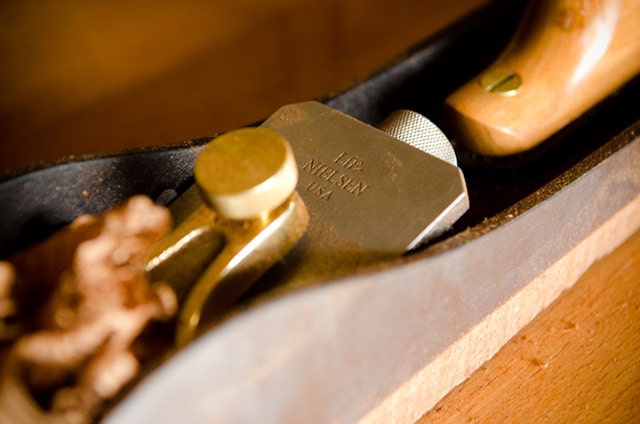
As you can see, the design is different than the normal bench planes; the bevel of the iron faces upward rather than downward. I touched on this earlier. Also, the bed of the plane sits at a lower angle. The cool thing about this type of plane is that it can be used in multiple configurations in addition to the main use as a low angle plane. For those who don’t know, a low angle plane is best used for handplaning end grain, like if you’re making an end grain cutting board, for example. The iron comes sharpened from the factory at a 25 degree angle. Add that to the 12 degree milled bed, for an effective low angle of 37 degrees.
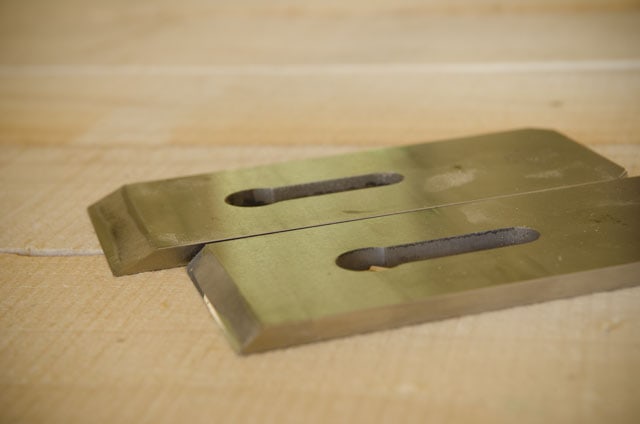
But you can also buy a second iron and sharpen it at around 35 degrees, and it’ll give you an effective planing angle of around 45 degrees, which is the same as a traditional bench plane. This is great for general purpose handplaning. And if you planned on handplaning figured wood, you could buy a third iron and sharpen it at around 50 degrees, which would give you an effective high angle of around 62 degrees.

And if that isn’t enough you can lastly buy a toothed iron dedicated for scrubbing. These toothed irons are especially designed for flattening difficult, figured wood.
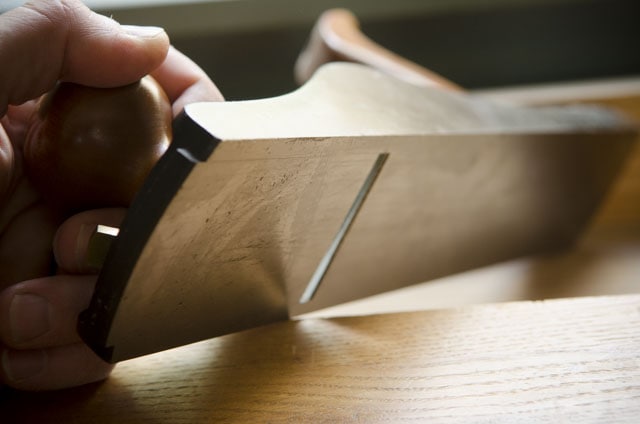
The mouths on these planes are easily adjusted so you can open and close it for different planing purposes: a tight mouth for smoothing and a wide mouth for scrubbing. I also find that this type of handplane works great with a shooting board.
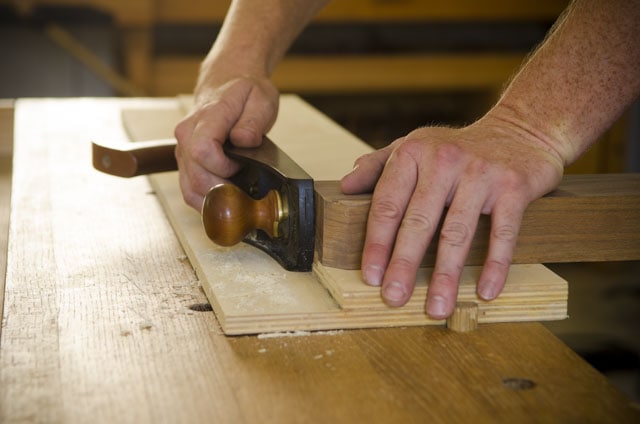
I personally own two different number 62 low angle jack planes (both inspired by the vintage Stanley No. 62 plane): one made by Lie-Nielsen (find it here) and one made by WoodRiver (find it here). Both of these planes work great. The Lie-Nielsen No. 62 has a bit more attention to detail, but is about $25 more expensive than the WoodRiver version.
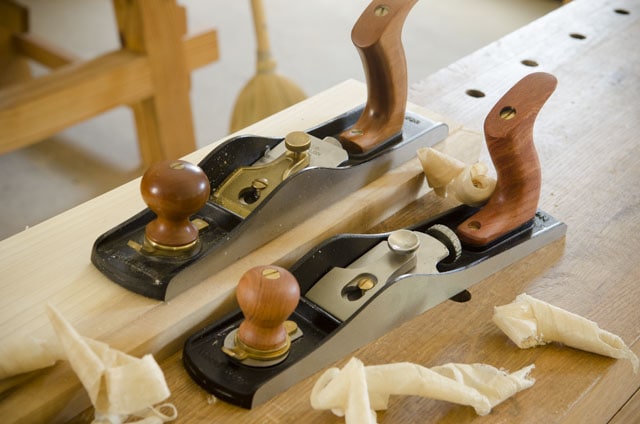
I would recommend against buying the vintage No. 62 Stanley low angle jack plane; the plane that the above planes were modeled after, because the handle is very small, there are some weak parts that tended to break, and the price is higher than buying a new reproduction plane. Stanley has also made a reproduction Stanley Sweetheart No. 62 Low Angle Jack Plane (see it here). I have not tried it out, so I can’t give my opinion on it. But from my experience with other modern Stanley reproduction tools, I haven’t been impressed compared with other brands (like Lie-Nielsen). Lee Valley also sells their Veritas Low-Angle Jack Plane, but I have not used it or heard anything about it, so I can’t share an opinion on it. And their handplanes are only sold on their website, so you won’t find any user reviews online.
If your budget allows for buying three separate bench planes (jack plane, jointer plane, and smoothing plane), then just buy an affordable vintage transitional jack plane or a wooden jack plane, and spend more money on a nice smoothing plane and jointer plane.
What about a Metal Scrub plane?
Recently the metal scrub plane has become popular with hobbyist woodworkers for flattening the faces of boards. However, these little planes weren’t traditionally used for flattening boards, and weren’t even manufactured until after power thickness planers & jointers started to emerge.
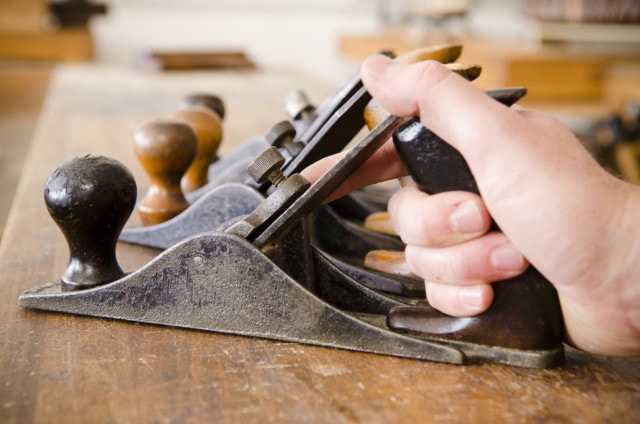
The traditional choice for scrubbing was a Fore plane, a Jack plane, or a smaller wooden scrub plane. The narrow metal scrub planes were apparently manufactured for house carpenters who needed a fast method for narrowing the width of a board (or door) when there wasn’t enough wood to be removed to require the use of a hand saw. I personally like using these scrub planes on the edges of thinner boards, but I find them too narrow for quickly flattening board faces or using on the edge of wider boards. So my recommendation would be to not purchase a metal scrub plane, like the Stanley No. 40 scrub plane.
Here are some quick links for jack planes for sale that you can look at:
- View vintage Stanley No. 5 Jack Hand Planes on Ebay
- View extra irons & chip breaker for No. 5 Jack Planes
- View vintage wooden jack planes on Ebay
- View vintage transition jack planes on Ebay
- View new Lie-Nielsen No. 62 Low Angle Jack plane
- View new WoodRiver No. 62 Low Angle Jack Plane at Amazon
- View new WoodRiver No. 62 Low Angle Jack Plane at WoodCraft
- View new Lie-Nielsen No. 5 Jack Plane (probably too expensive for a jack plane)
- View new wooden planes from Old Street Tool (expensive)
* How do you know the age of a Stanley handplane? Check out my Stanley Bailey Handplane Type / Age Study (click here)
Buying Jointer Planes / Try Planes
A jointer plane, or “Try” plane, is an important bench plane for flattening the faces of boards and particularly for squaring the edges of longer boards to get a 90 degree edge. This is essential for when you’re gluing the edges together, or when you need a square reference edge and face for marking & measuring your joints.
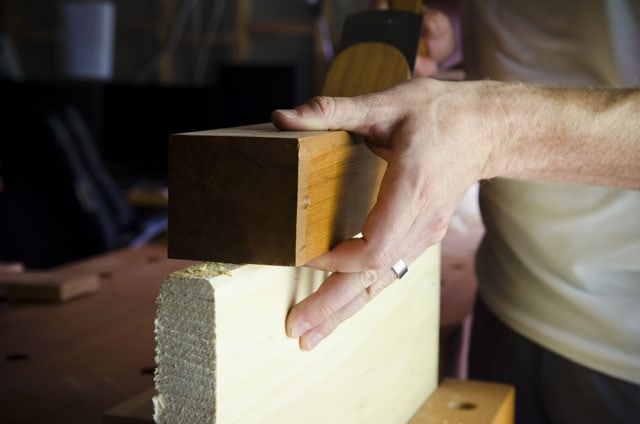
Wooden bodied jointer planes are a good and affordable option if you can find one in descent condition and want to spend the time to refurbish it. Or you can make a jointer plane. In fact, I created a video with handplane expert Bill Anderson on making a lovely 18th century jointer plane. You can purchase the digital video or DVD in my online store if this is a route you’d like to go. I made one (pictured above), and love the way it works. And I consider it a family heirloom to be passed down to my kids and grand kids. Here’s a preview of the video:
And just like with wooden smoothing planes and jack planes, wooden jointer planes require a bit more work to adjust, and can be a bit puzzling when refurbishing.
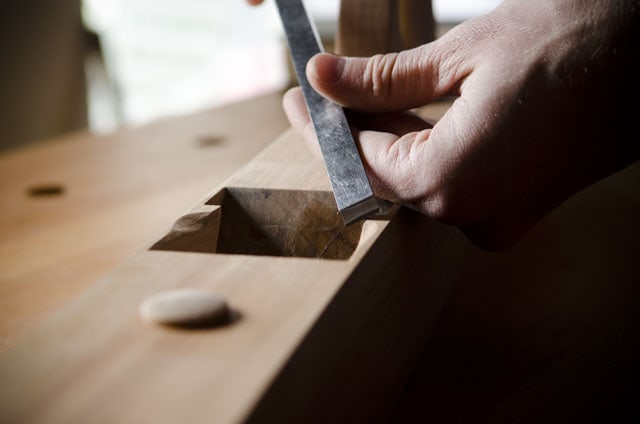
The same advice that I shared about buying metal smoothing planes applies here with buying metal jointer planes. The Bailey style number 7 jointer plane is the most popular option, especially the Stanley Bailey No. 7 jointer planes (find them here). I would avoid buying a number 8 jointer plane, unless you’re pretty strong. It’ll wear you out. You could also buy a Stanley No. 6 Fore plane (find them here). It’s almost as long as a No. 7 jointer plane, and will work nearly as well for jointing boards. But if you buy a No. 7 jointer plane, then it won’t really be necessary to buy a No. 6 or No. 8 plane.
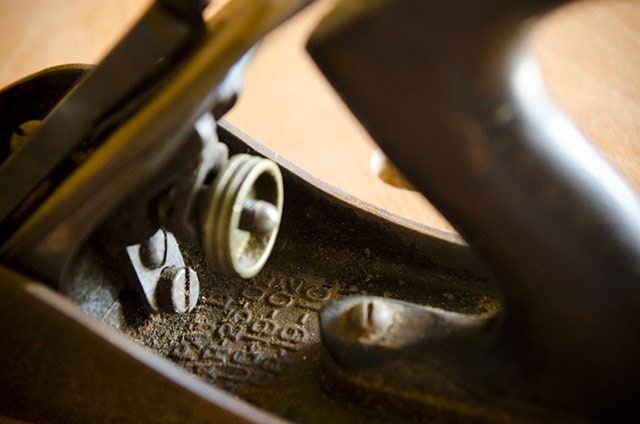
And as I mentioned earlier I prefer purchasing Stanley or Record planes that were manufactured before World War II. Check out my Stanley hand plane age identification tool (here). A type 11 (1910 patent date) Stanley Bailey jointer plane (or somewhere close to that patent date) is my favorite “type” of Bailey bench plane. After refurbishing, it would be an ideal jointer plane for the novice or expert.
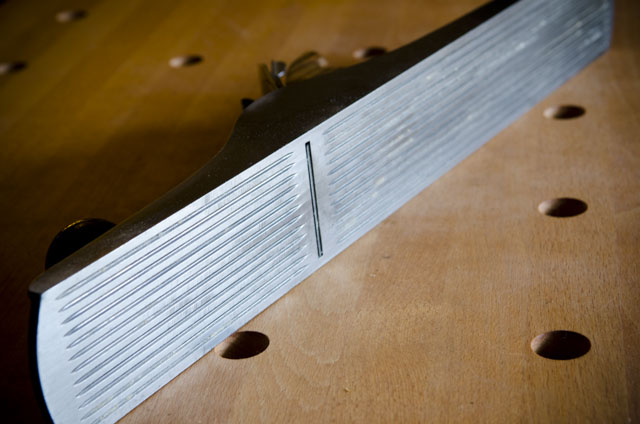
And if you can help it, I actually recommend that you don’t buy a metal jointer plane with the popular “corrugated sole”, as seen above. These ridges were originally marketed as a feature that was supposed to make hand planing easier due to an alleged reduction of friction, but I think that was just a marketing ploy. It actually makes jointing the edge of a board more difficult for me, because the ridges often make the plane’s sole tip. It’s not a huge deal; just a small inconvenience. So if you find a good deal on a jointer plane with a corrugated sole, then don’t pass on it. I have several corrugated bottom jointer planes, and for the most part they work perfectly fine. The only real benefit that I’ve seen with corrugated hand plane soles is that it does take a little less time to flatten the sole when I’m refurbishing a plane. But I only do that once with a plane. One reader sent me a message notifying me that he discovered that resinous pitch pine is easier to plane with a corrugated sole, since there is not as much gum to drag the plane. If you plane resinous wood, then I guess you should get a hand plane with a corrugated sole!
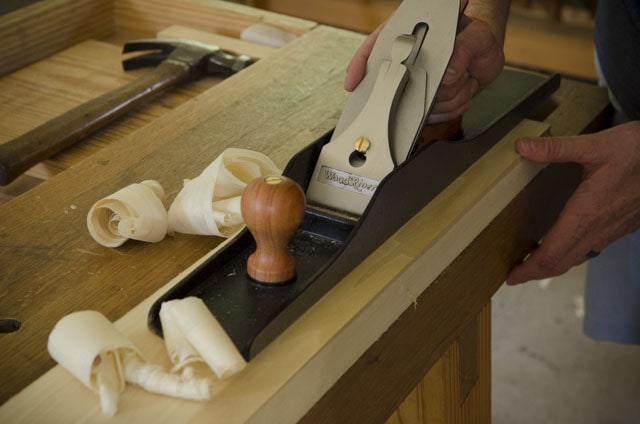
You can also find a vintage Stanley Bed Rock No. 607 jointer plane for about $100 – $300, depending on the condition. Check them out here. And if you’ve got a larger budget and you don’t want to do rehab work, then the Lie-Nielsen No. 7 jointer plane is exceptional. It runs about $465 (including tax & shipping). I also own the WoodRiver No. 7 jointer plane (pictured above). Like the Lie-Nielsen No. 7, it’s also a Bed Rock style plane. It works exceptionally well, and it’s about $100 cheaper than the Lie-Nielsen No. jointer plane. You can purchase it here for about $349.
I wouldn’t recommend buying the more modern Record No. 7 jointer planes. I’ve got one of them, and the quality just isn’t as great as vintage Record No. 7 jointer planes. The iron doesn’t sharpen well, the edges of the plane body are sharp, and the parts are pretty cheaply made.
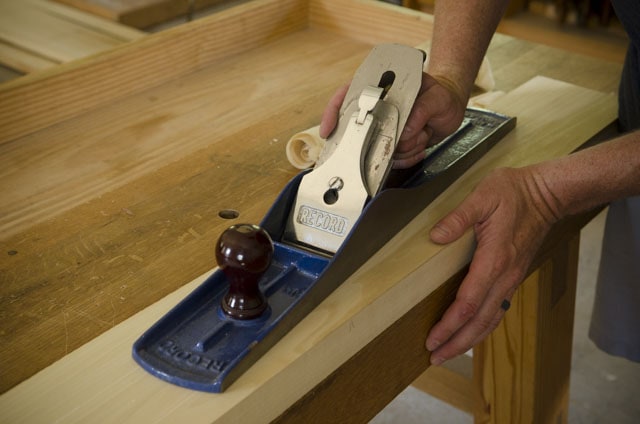
Veritas (new) and Clifton (new and vintage) also apparently make good bench planes, but I just haven’t used their bench planes much. I did try out a student’s Veritas jointer plane, and though it worked nicely, I had one concern: the design would have prevented the jointer plane from being used on a shooting board.
Here are some quick links to these different easy-to-find jointer planes that I’ve mentioned:
Buying Smoothing Planes
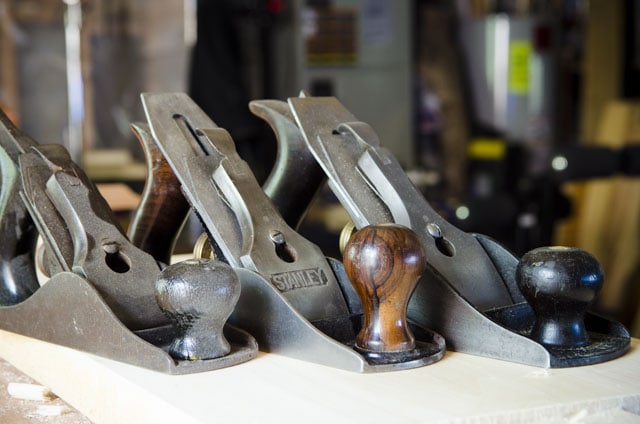
Again, a smoothing plane is a shorter handplane that’s tuned up go give the best finish possible on a board; a finish that is usually superior to what sandpaper will give you. The short hand plane length allows you to work the plane into smaller areas with reversing grain. For woodworkers that don’t have a large tool budget, I have a couple recommendations.
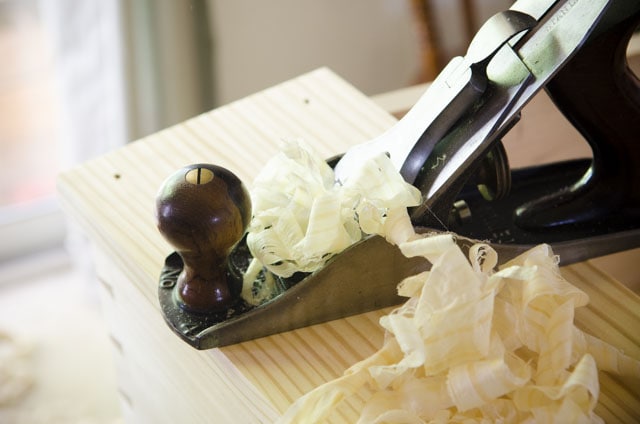
The first choice of most budget-conscious woodworkers is a Bailey style smoothing plane. Several manufactures of the past made good versions of these planes in the late 1800’s and early 1900’s, especially Stanley. They made millions of Bailey style smoothing planes. Most people opt for a number 4 size plane (pictured above). If your hands are a bit smaller, then a number 3 works great (pictured below).
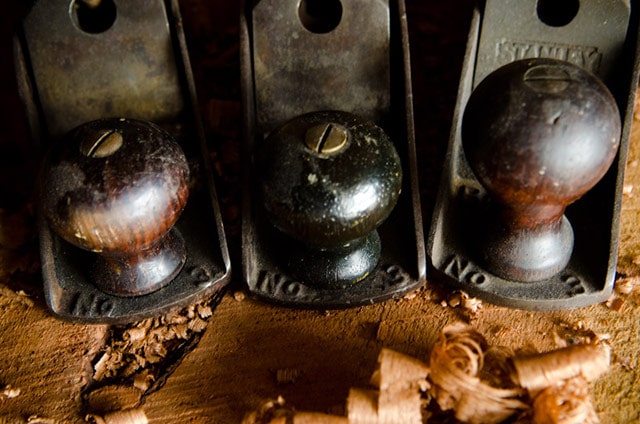
If you prefer a heavier smoothing plane to give more power to your planing, then a number 4-1/2 size smoothing plane is ideal (pictured below). The 4-1/2 is more rare, and thus more expensive than a number 4. And a number 3 is usually less expensive than a number 4. I have large hands and prefer a number 4 or 4-1/2, but I also own a few number 3’s and I can certainly use them without discomfort. They just give a little narrower shaving.

One of my favorite recommendation for a really tight budget is a coffin smoother (pictured below). These lovely little wooden smoothing planes are usually under $25 in good shape, and work amazingly once they’re sharpened and tuned up. They always have thicker irons and chip breakers, which makes plane chatter much less likely.
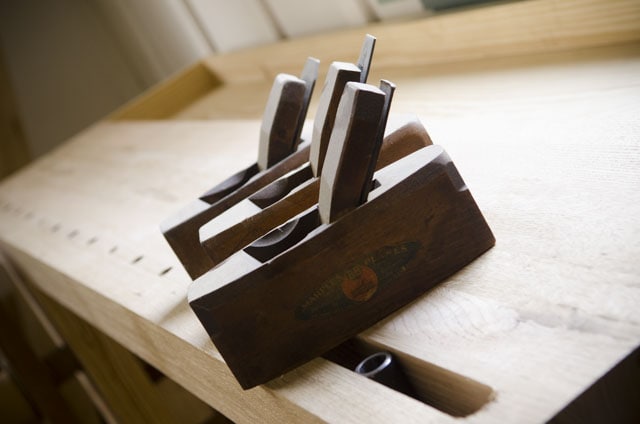
And in my opinion they aren’t as time consuming to rehab as metal planes; although I do occasionally run into puzzling problems that I need to solve with them. But usually adjusting the shape of the wedge and inlaying a tighter mouth is the most common improvement that people make on these hand planes.
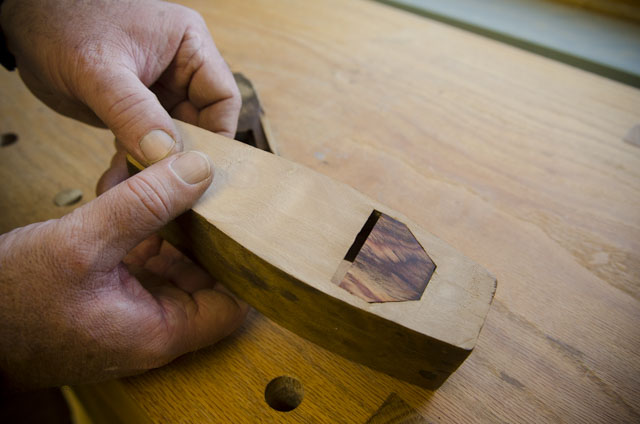
Again, it takes a bit more work to adjust wooden hand planes, but once I get it dialed in for a fine shaving, I usually don’t have to do much tuning until it’s time to resharpen the iron.
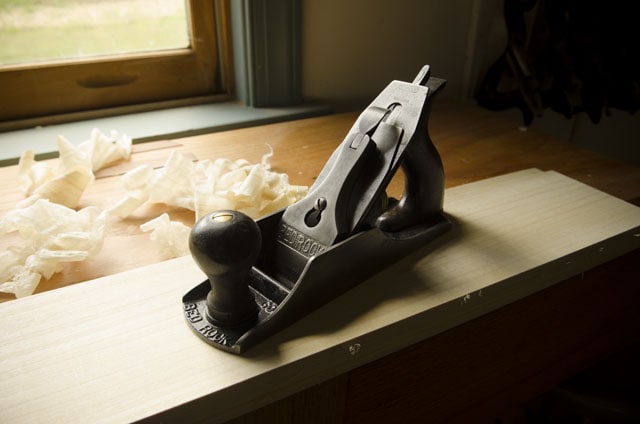
As I mentioned before, for those with a moderate budget, I recommend that they consider buying a Bed Rock style smoothing plane. If you like the idea of rehabbing an old tool, then go for a vintage Bed Rock 603, 604, or 604-1/2 smoothing plane. Last I checked they were running over $200 for a plane that needs a good amount of rehab work. I like rehabbing handplanes, because it’s fun bringing these handplanes back to their glory days. So this is my favorite route.

If you don’t want to fuss with rehabbing, then look at one of these newer smoothing planes made by modern manufactures. A couple manufactures do a great job with the Bed Rock style planes, and they also feature thicker irons and chip breakers, which vintage Bed Rock planes and Bailey planes don’t have.
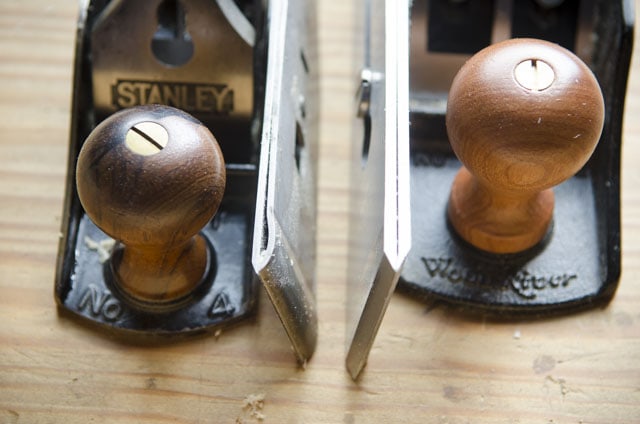
WoodRiver sells their Bed Rock style number 4 smoothing plane for around $200 and their number 4-1/2 smoothing plane for just over $200 (pictured below). You can find them here. Rather than using the #604 numbering system, they opted for the simple #4.
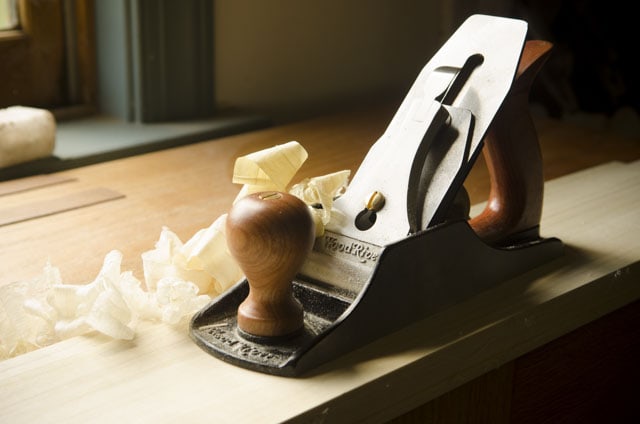
I own the WoodRiver No. 4-1/2 smoothing plane, and it works exceptionally well once it’s sharpened. Don’t expect any tool maker to deliver a handplane that is perfectly sharpened and honed to an acceptable level. Not even Lie-Nielsen.
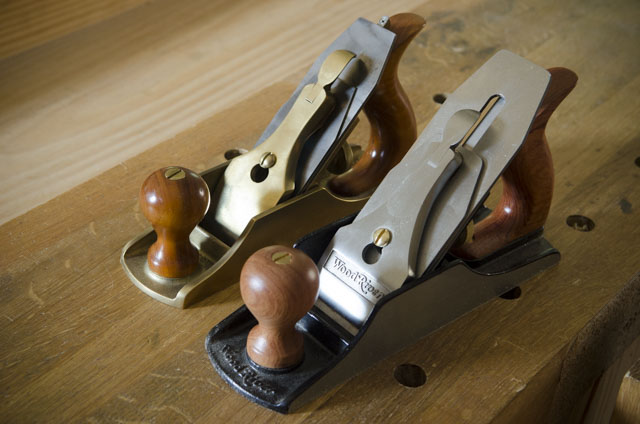
Lie-Nielsen also sells exceptional smoothing planes, also in the No. 4 size (pictured above) and the No. 4-1/2 size. And while their smoothing planes have a bit more attention to manufacturing detail, in my side-by-side test of a brand new Lie-Nielsen smoothing plane with a brand new WoodRiver smoothing plane I didn’t find the Lie-Nielsen smoothing plane to give superior results on the wood. Neither brand gave great results right out of the box, but after I honed the two planes’ irons at the same time, I did a side-by-side comparison and found them to both cut nice shavings and leave a very smooth surface. The Lie-Nielsen planes seem to have a smoother depth adjuster wheel.
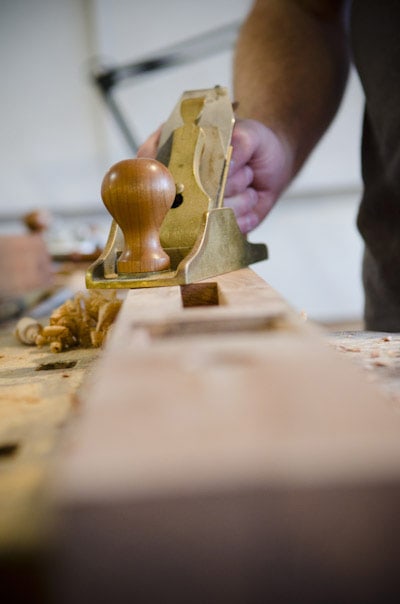
The Lie-Nielsen No. 4 smoothing plane will cost you about $380 (including tax & shipping) and the Lie-Nielsen No. 4-1/2 plane will cost you about $360 (including tax & shipping). Why is the No. 4-1/2 cheaper than the No. 4? Because the No. 4 comes with a bronze body, and the No. 4 comes with a steel body. Every year or so Lie-Nielsen will run a batch of bronze No. 4-1/2 planes, but they cost $750 (plus tax and shipping).
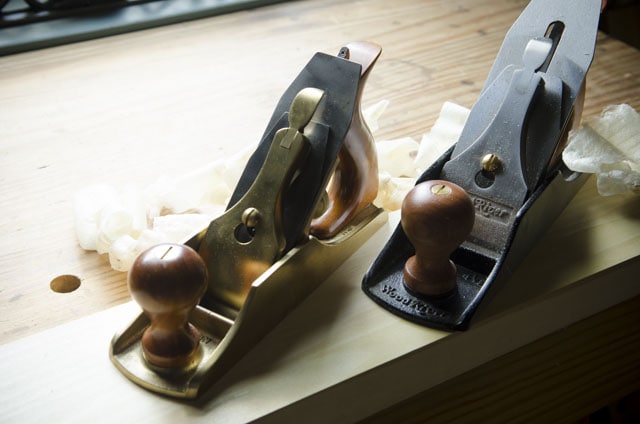
Since both of these Bed Rock style smoothing planes make incredible shavings, I feel like these WoodRiver smoothing planes are a much better value. You can find links to both of these smoothing planes below.
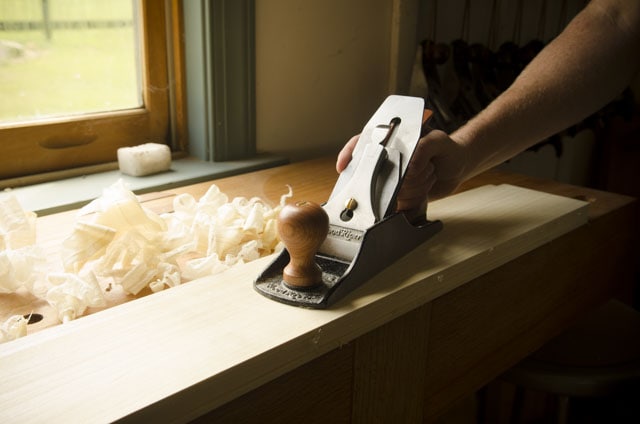
And, of course, if you’ve got a larger budget, then I really like Scottish infill smoothing planes (i.e. “British” infill smoothing planes), which I talked about earlier. Not only are these planes attractive (pictured below), but they’re heavy and precision made, with tight mouths and solid bodies, which makes for excellent smoothing.
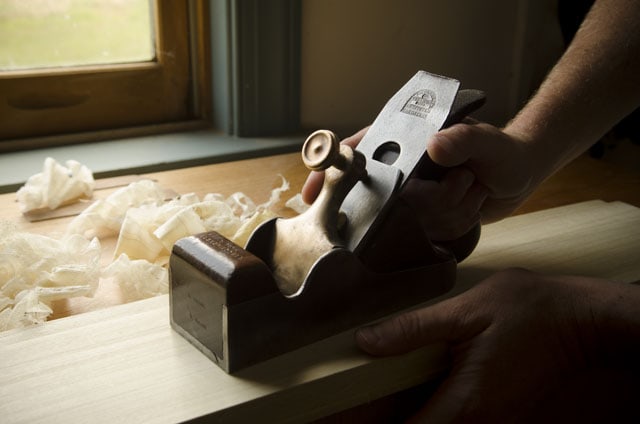
However, due to the high demand and low availability of these lovely hand planes, they are typically priced pretty high (especially those made by modern tool makers). The two most common infill plane makers were Norris and Spiers, and the more sought after infill planes were made before World War 2. They are usually just referred to as “Pre-War”. But “Post-War” infill planes are also high quality. You don’t have to get hung up on brand names, and can even find a bargain (under $300) if you look for infill planes without a maker’s name. Some people really prefer the thumb adjustment wheel, but you can also save some money by forgoing this option. You can find some good deals on infill planes here.
But to be honest, I’ve found that a Bailey-style smoothing plane works very well, without chatter if it’s highly-tuned and oiled or waxed. Here are some links to the planes I’ve talked about:
- View antique Stanley No. 4 smoothing planes on Ebay
- View antique Stanley No. 4 1/2 smoothing planes on Ebay
- View antique Stanley No. 3 smoothing planes on Ebay
- View antique Stanley 604 Bed Rock hand planes on Ebay
- View WoodRiver smoothing planes at Amazon
- View WoodRiver smoothing planes at WoodCraft
- View new Lie-Nielsen smoothing planes
- View vintage coffin smoother planes
- View vintage Scottish / British infill smoothing planes
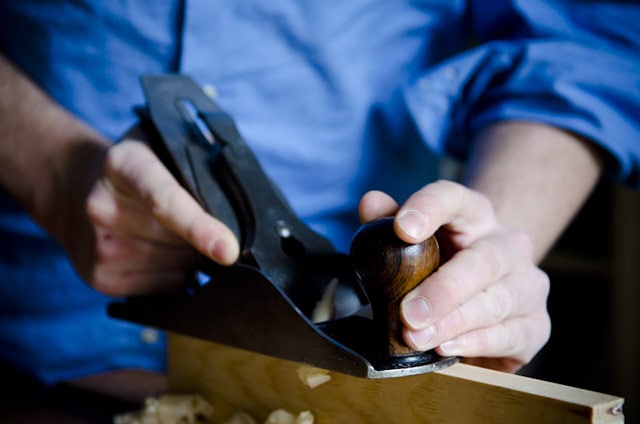
Buying Block Planes
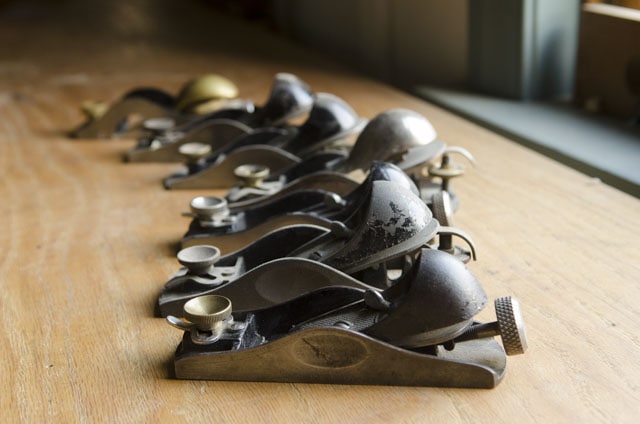
A simple little metal block plane is used for a lot of woodworking tasks, like truing up end grain on board ends, creating chamfers on board edges, trimming wood joints like tenons and dovetails, and much more. Block planes are relatively new compared with other handplanes…they only appeared in the mid 1800’s, but it’s small size and versatility have made block planes a popular tool among woodworkers.
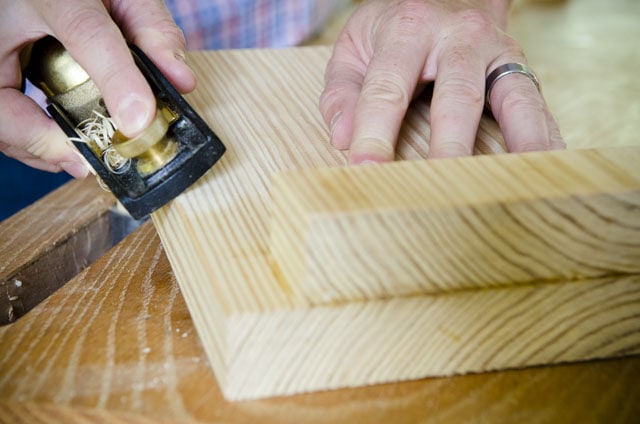
Block planes come in both low angle and higher angle configurations. But I feel like the low angle versions are much more useful because they excel at cutting end grain. When buying a block plane, it’s a good idea to spend a little more for a low angle version.
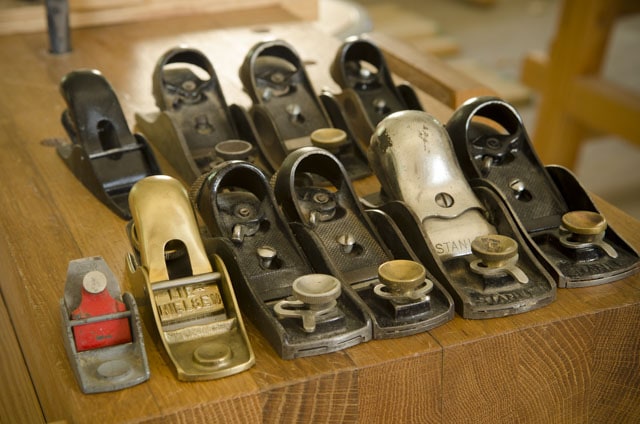
Because of the relative ease of manufacturing block planes, a lot of companies make them. And a lot of those block planes are bad. So you need to be careful and buy from reputable tool makers. I’ve got a few vintage block plane models that I love, and a couple modern block plane models that I love.
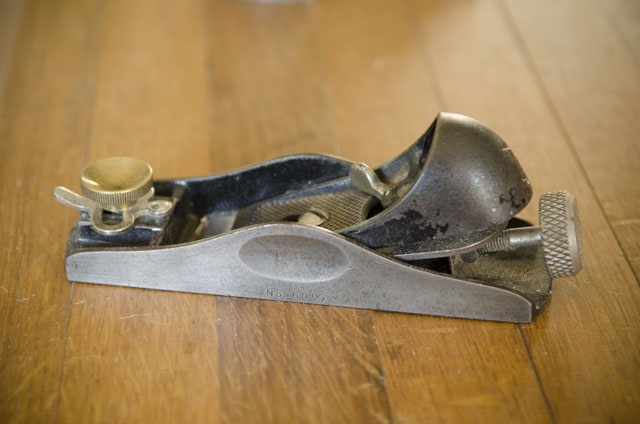
One of my favorite vintage block planes is the Stanley No. 60-1/2 low angle block plane with adjustable mouth. The low bed angle and adjustable mouth makes this block plane excel at trimming end grain. And opening the mouth works great for more rough work.
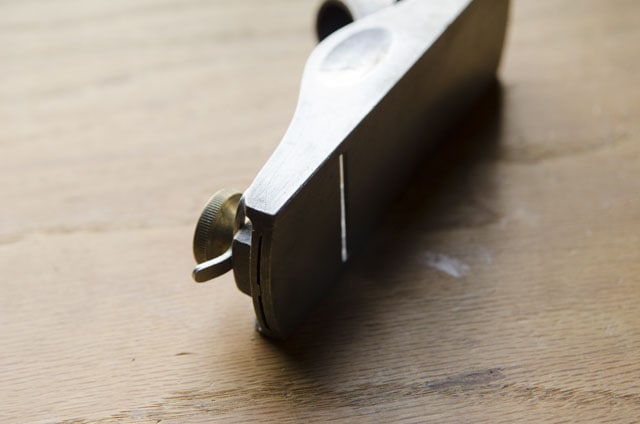
I also love the vintage Stanley No. 65 low angle block plane. It was made with a cool “knuckle cap” that makes for easy adjustment and comfortable handplaning. And like the No. 60-1/2 it also came with an adjustable mouth (1905 and onward model years).
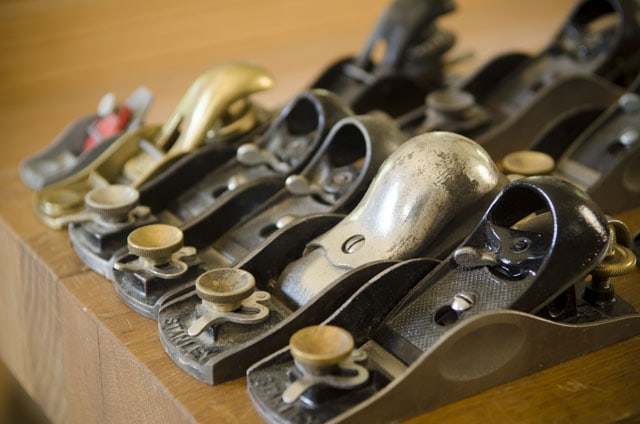
These two vintage block planes are widely considered the best block planes ever made. Depending on the condition, these block planes run anywhere from $40 to over $150 (much more if they’re mint and in a box). And sometimes it’s a bit hard to find them, especially the Stanley No. 65 low angle block plane.
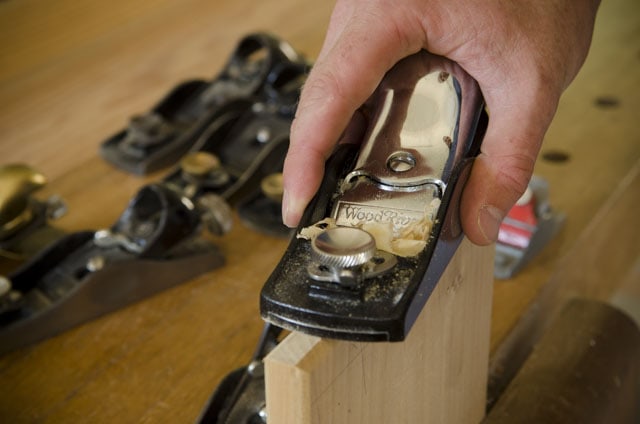
Fortunately a couple of good tool manufacturers have come out with nice block planes. WoodRiver made a replica of the Stanley No. 65 low angle block plane (pictured above), which runs about $125 (find it here). I own the WoodRiver low angle block plane and the vintage Stanley No. 65 block plane, so I’ve had a chance to compare them. After being sharpened they both work exceptionally well, although the vintage version requires flattening of the sole and some other tune-up work before it’s ready to use. They’re also both really comfortable on my hands.
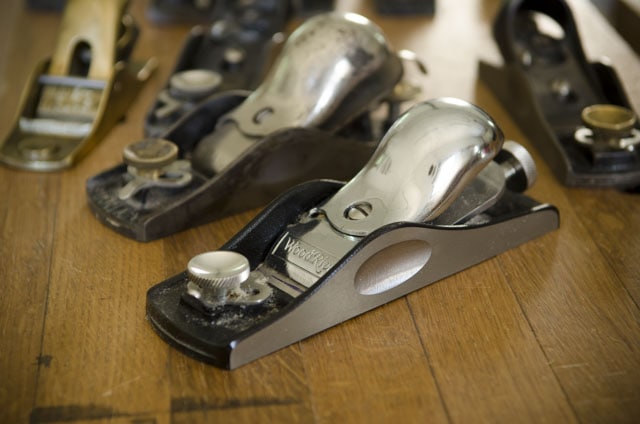
Lie-Nielsen and Veritas also make some nice block planes. I’ve used Veritas block planes a couple times, and the experience was good. But I’ve used Lie-Nielsen block planes many times, and I own one model, the Lie-Nielsen low angle rabbet block plane (find it here):
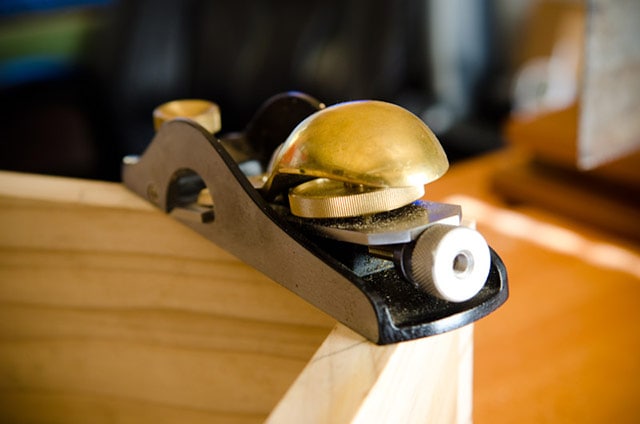
This block plane runs about $175 (plus tax & shipping), but is quite a nice special purpose plane. The blade runs from side-to-side, allowing you to trim joinery or even cut a rabbet (though I’ve found it to be a bit difficult with such a small plane).
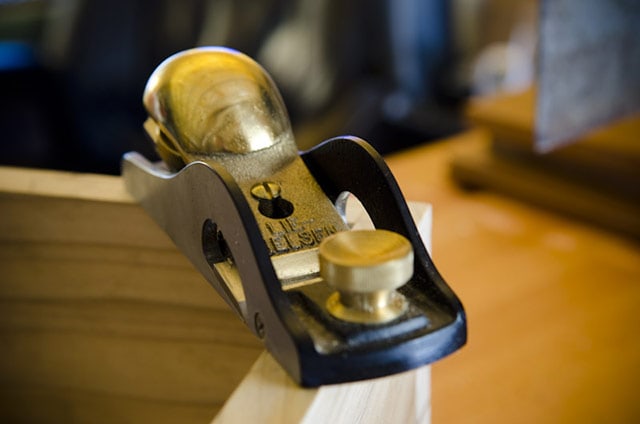
However, it doesn’t have an adjustable mouth. So probably a better option would be the Lie-Nielsen No. 60-1/2 low angle block plane (find it here). It’s also a reproduction of the Stanley No. 60-1/2 low angle block plane, but with some custom design changes by Lie-Nielsen (like the added knuckle cap).
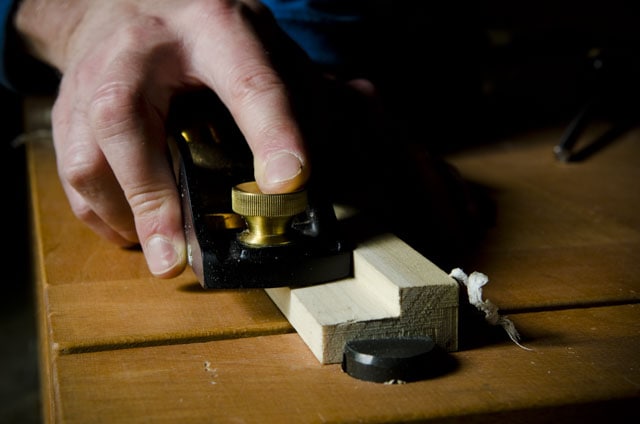
But the Lie-Nielsen version is $50-$60 more expensive than the WoodRiver version, so I recommend the WoodRiver Low Angle Block Plane.
If you find that a low angle block plane is outside of your budget, then a normal angle (general purpose) block plane (like the one pictured below) will work somewhat well for you. Just get it really sharp. This is a Stanley No. 9-1/4 block plane. The Stanley No. 9-1/2 block plane was similar, but had an adjustable mouth.
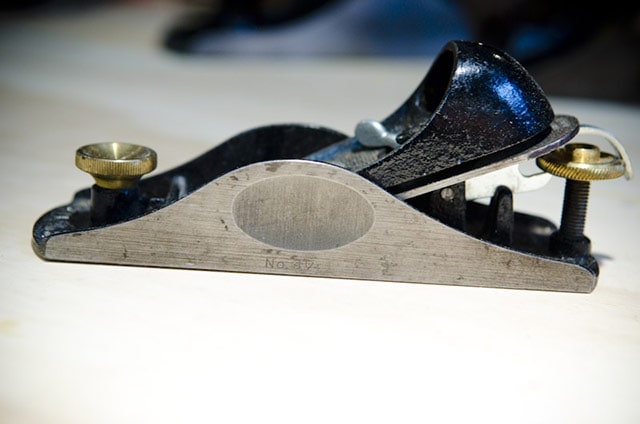
Here are links to some of my favorite block planes:
- View the WoodRiver low angle block plane
- View vintage Stanley 60-1/2 low angle block planes on Ebay
- View vintage Stanley 65 low angle block planes on Ebay
- View vintage Stanley low-angle block planes
- View new Lie-Nielsen low-angle Rabbet Block Plane
- View new Lie-Nielsen 60-1/2 low angle block plane
- View all new Lie-Nielsen low-angle block plane models
- View used Lie-Nielsen low-angle block planes on Ebay
- View vintage Stanley No. 9-1/4 block planes on Ebay
- View vintage Stanley No. 9-1/2 block planes on Ebay
- View vintage Sargent No. 507 block planes on Ebay
Continue to page 2/3: “Buying Joinery Planes”…
TOOL GUIDE SHORTCUTS:
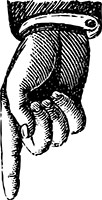
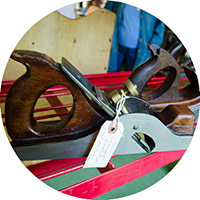
HAND TOOL BUYER’S GUIDES
- Intro to Buying Woodworking Hand Tools
- Workbench & Tool Storage
- Layout, Marking, & Measuring Tools
- Handplanes
- Handsaws
- Chisels
- Sharpening & Honing Supplies
- Mallets & Hammers
- Hand Drills, Braces, & Bits
- Tools for Curved Work
- Tools for Green Woodworking
- Woodworking Clamps, Gluing & Fasteners
- Tools for Wood Carving
- Products for Wood Finishing, Sanding & Scraping
- Wood Turning Tools & Lathes

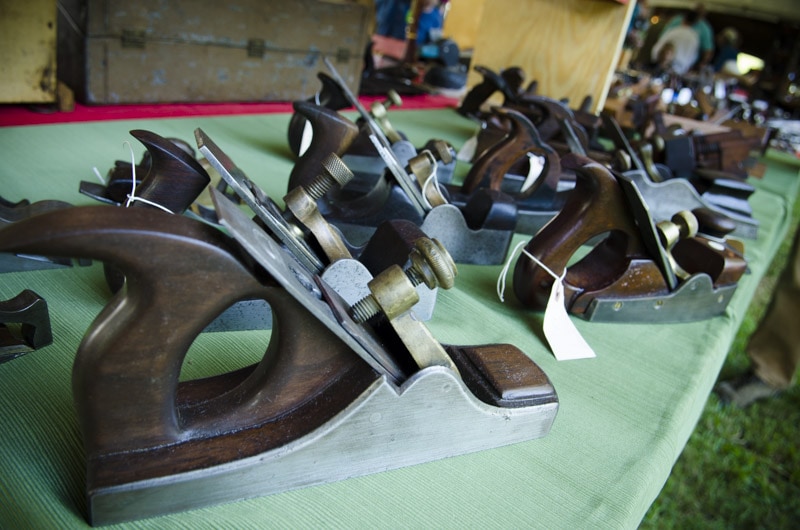
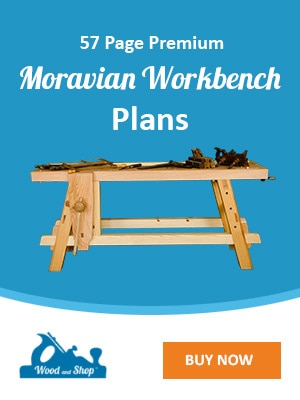
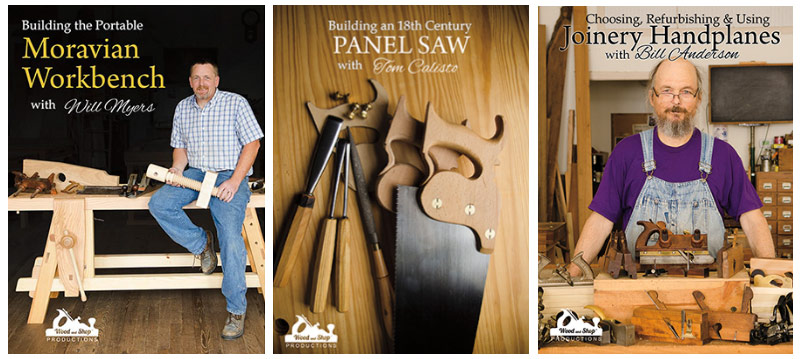
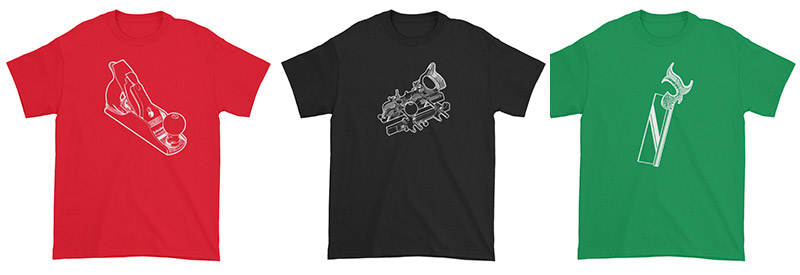
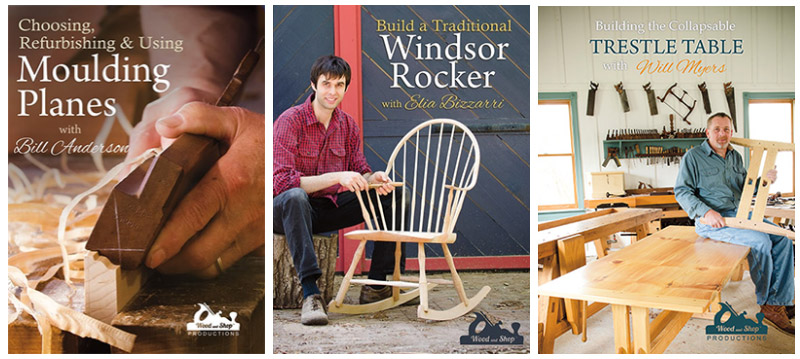
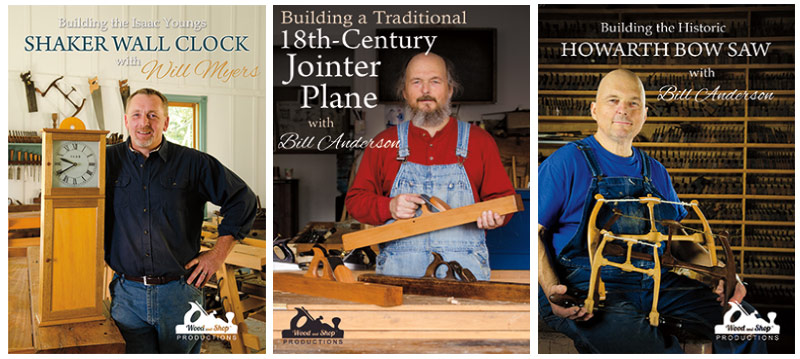
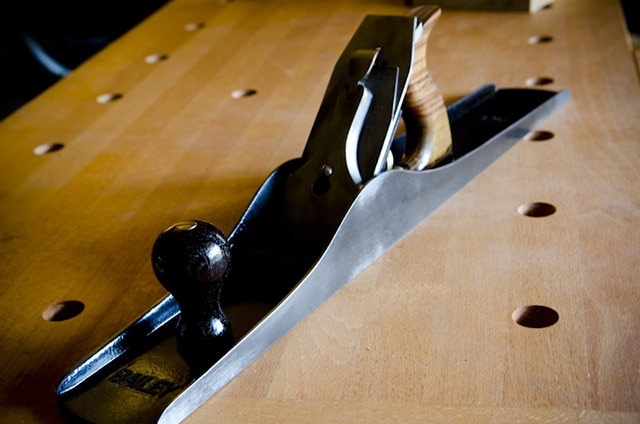
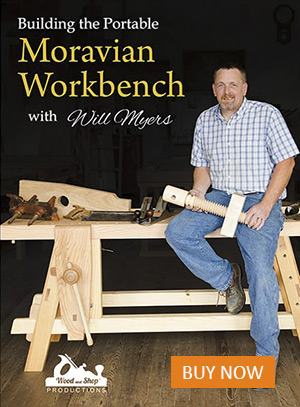
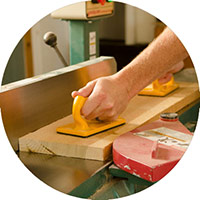
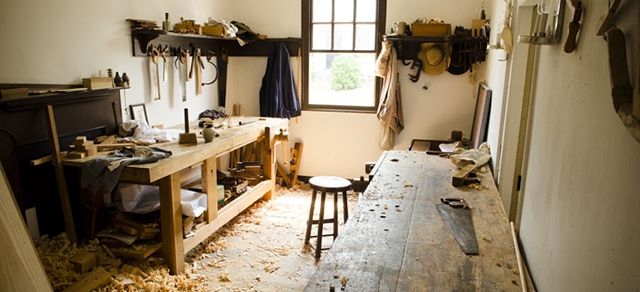
I recently decided to get back into woodworking after 50 year break from my brief intro into woodworking in Jr. High School. I pulled out a box of my father’s old tools and I found a treasure of tools including Stanley No. 101, 103, 4, 3 handplanes. I also picked up a couple of wood Jack planes including a No. 33. I hope that this Guide and your other guides will get me back into woodworking. Love your videos too.… Read more »
I have been making different type of tables and need more of the clamps for doing larger tops.
any of the video on hand plane will work
I enjoyed all of the buying guide articles and videos. I used this information in searching out and buying startup tools for woodworking with hand tools. Thanks for you time and effort in putting this information together, it has helped me greatly.
Video on “Building the Historic Howarth Bow Saw with Bill Anderson”
T-shirt with the Wood and Shop logo in dark chocolate.
I think your list of Urgent planes could be shortened a bit, you shouldn’t need all of those right away. Some you might never need.
The first four are essential. After that, I would say a router and possibly moving fillister/rabbit but I think the rest could be moved down to the Semi-urgent or even Non-urgent list.
Thanks for your opinion Mike…I value input on here!
Have you ever tried an ECE wooden try plane? They appear to be an inexpensive way to get top of the line quality, but reviews seem to be scarce.
Nope, I haven’t tried them. Just curious, how do you know they are “top of the line quality” if you haven’t been able to read reviews? Have people told you about them?
They are top of the line. It’s the premium European brand.
Do you know anything about Plane Master?
Nope
Are Hock blades worth the money?
Yes, but I like the Veritas blades & chip breakers better.
I am just getting into woodworking and am starting to piece together my tool set and I thought I saw a list of vintage hand plane manufacturers and models with how desirable they are on this site somewhere. I have seen a few Worth planes for a good price and wanted to know if they are any good. Love the guides and videos, very helpful! Thanks!
That is my chisel guide. The major vintage handplane manufacturer would be Stanley, and they are easy to find. Just read through my handplane guide.
Seems like the section in jointers is missing. Also the description of bevel ups is a copy of the description of transitionals. Other than that, I loved every minute. Thanks!
So strange, the page went missing. We’ve got it restored if you want to read it now. Thanks for the head’s up Sean!
Yes I do think that you should do a video on Rehab of planes
there is little info or correct info of doing rehab of Planes
My wifes calls me Rust hunter always hitting flea markets looking for hand tools .
I have spent hours, days on planes , doing rehabs
I’m sure your help is needed in a lot of Rehab work
Thanks for the feedback Jim! Yup, sounds like you’ve got the tool disease…careful because it’s incurable!
Joshua, I love your tool guides. It is clear that you actually use the tools you recommend, likely a by product of running a woodworking school and helping students solve problems with them. I have a pile of vintage hand planes I have slowly acquired at flea markets, etc. Some I have tried to clean up and sharpen with mixed results. I even tried to do some rehab following guidance I have pulled together from various sources, but I haven’t… Read more »
Hi Gordon, I’m glad the guides have helped you! I’ll try to answer your questions here: – It’s quite important to have the frog sit flush with the base and be flat where the blade sits. It doesn’t need to be a fine “finish”, but you should flatten the frog on sandpaper (on a flat surface, like glass or granite or melamine). -I don’t fall for the expensive oils for lubricating tools. I use inexpensive mineral oil or 3-in-1 oil,… Read more »
If I read the chart correctly, the No. 5 G12-005 plane I own is from 1919 – 1924.
I shaved my eyebrows off with the Lie-Nielsen low-angle Rabbet Block Plane by accident, but my face has never been smoother. These things really have a mind of their own but there’s nothing like that smooth wood finish.
Ha, ha!
Is there anything wrong with modern Stanley 60 1/2 block planes? It appears they never stopped making them and you don’t mention specific versions or how to identify them.
Hi Matt, I haven’t tried the modern Stanley block planes yet, but I have tried their low angle jack plane, and liked it. Stanley’s quality suffered for many years (after WWII), but they’re trying to get back into the hand tool game. They haven’t caught up yet, but some of their modern tools aren’t too bad.
how relevant is the article in 2021?
Sorry, I’m confused by this.
I have had my Dad’s tools for years and had only a rudimentary understanding of how to really use them – this site has expanded my knowledge and use of these tools.
very informative
I have a Baker jack plane that I think was made before or soon after WWII. There are numbers in the casted parts and the Baker name is etched on the blade. Would appreciate any comments that further identify this tool.
I’m grateful for this guide, but the pricing is quite outdated. I wish I could find any plane in decent shape for $50. I’m lucky to find a rough shape one for under a $100
Thanks for the feedback Zack. We’re in the process of updating the guides.
Do you need to sharpern a new from shop plane or is it good to go a no5
I don’t know of any hand planes (new or used) that are ready to go out of the box. All require sharpening.
I know it’s not in line with your aesthetic, but have you tried the Amazon Basics No.4 Adjustable Universal Precision Smoothing Bench Hand Plane? I’d love to hear a review on it from you, good or bad. Thanks
Sorry, I haven’t, but will look into it!